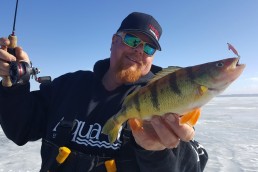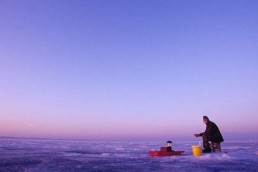March Ice-Fishing Rocks for Everything
SHARE THIS POST
“Bro” Brosdahl’s tips for March ice-fishing in Minnesota
March ice-fishing is my favorite. The walleye season is over on the inland waters of Minnesota, but there are extended seasons for walleyes, sauger and northern pike on many of the border waters. Other than the occasional run to the border for walleyes and sauger, or a trip to Devils Lake in North Dakota for walleyes and perch, my entire attention is devoted to March ice-fishing for crappies, sunfish and perch (and the occasional eelpout and whitefish).
If you see what I did there, you might get the idea that everything is biting in March around most of the ice belt. You got the correct idea. March is a transitional month for many fish species. Most fish are in one location at the beginning of March. By the end of March, many of those same fish could be miles away. They could be in a different part of the lake or a totally different lake or river connected to their home lake.
Timing your trip
Timing is everything in March ice-fishing. For anglers to find most species of fish, they have to know where the fish were and where the fish are going. Then, they just have figure out where the fish are between the two locations. I use my Humminbird Helix 7 Ice with Chirp and the LakeMaster map chip to help me navigate and find fishy areas. The sonar feature with Chirp maximizes target separation, so I can tell the difference between minnows and larger fish.
Many things trigger fish movements in March, including longer days and warming temperatures that cause run-off into the lakes. Plus, the fish feel a biological need to be closer to their spawning sites. Fish always need food, regardless of the time of year. When fish migrate, they need to eat more because they burn a lot of calories swimming long distances against current. Fish also need additional food when they are in the final stages of gestation before spawning. All that hunger leads to a lot of bites on March ice-fishing trips.
Somewhere between here and there–locating migrating fish
Fish don’t swim in a straight line from their wintering areas to their spawning sites. They may blow through some areas quickly. In other areas, they may take a detour to find food and places to rest. Walleyes, perch, saugers, northern pike and eelpout all spawn early in the spring, while crappies and sunfish spawn later.
A good portion of the walleye population in larger lakes usually spawn in rivers connected to their home lakes. Walleyes come from all parts of the lake in March to stage close to the rivers where they will migrate and spawn. A good example of this, in my area, is Pine Island in Lake of the Woods. Walleyes gather here before running up the Rainy River to spawn. Similar patterns happen all across Minnesota, Canada and the Great Lakes.
The things to bring to boat more fish
Anglers can aggressively jig to target the largest and most active walleyes late in the March ice-fishing season. I like Northland Buckshot Rattle Spoons, Glo Shot Spoons or Puppet Minnows for walleyes. I like to use longer rods when I fish outside in March—30- to 35-inch Frabill Bro Series Rods with 371 Straightline reels. Medium-action rods work for walleyes and light or medium-light action rods work for crappies, bluegills and perch. I also like noodle rods for panfish.
The ice sheet on the lakes melts from both the top and the bottom, late in the season. The ice can fall away like a trap door when the ice gets rotten and anglers walk or drive across the wrong spot. Ice can also get weak around reeds and wild rice, especially when parts of the weeds are sticking through the ice, absorbing the heat of the sun. I always wear my Frabill IFloat Jacket late in the season to play it safe.
Are you enjoying this post?
You can be among the first to get the latest info on where to go, what to use and how to use it!
You can also play it safe by sticking to the shallows, check out our article on targeting pike in shallow water.
Eelpout and big northerns
The first fish to spawn in the spring are eelpout, which lay their eggs under the ice in March. Eelpout eggs are large. Their embryos need enough food to last them more than a month under the ice before they hatch. Anglers can catch eelpout on humps and bars with direct access to the deepest parts of the lake. Eelpout have a good sense of smell and poor eyesight. Anglers should fish eelpout at night with large glow jigs or glow spoons tipped with live bait and fished with aggressively near the bottom.
Northern pike are also on the move in March. Pike like to spawn in calm backwaters and smaller streams that flood and form spawning pools. Pike occupy many different types of habitat in winter, so they are spread out into most parts of the lake. The pike head towards bays and shoreline structures close to their spawning sites as March progresses. Anglers can fish for pike with tip-ups and large live minnows or dead oily baits like smelt or herring. I like using the round thermal tip-ups from Frabill to help keep the holes from filling with snow and ice.
Picking out perch
Perch lay their eggs in strands over old standing weeds left over from last summer. Perch begin spawning almost immediately after the ice is off the lakes, so they are in prespawn feeding mode most of March. I like plastics for late ice perch, so I don’t have to change my bait every time I catch a fish or miss a bite. Northland Bro Series “Gill Getters” and “Mud Bugs” tipped with Impulse plastic Skeleton Minnows, Slug Bugs or Mini Smelt work for late ice jumbo perch.
Sunfish and crappies spawn in June, when water temperatures reach the mid 60s. Their movements during March are more related to food and close to the same areas where anglers find them in the spring.
March is a mad time of year on the lakes. Bring ice picks for safety and remember to let the big bluegills go.
Author notes
Brian ‘Bro’ Brosdahl is a nationally known fishing guide and lead spokesman for many of the top companies in ice fishing. He can be contacted at bbro@paulbunyan.net or through his website at brosguideservice.com. Follow him on Instagram, Twitter and Facebook.
MWO
SHARE THIS POST
You may also like...
Did you enjoy this post?
You can be among the first to get the latest info on where to go, what to use and how to use it!
Brian 'Bro' Brosdahl
Outdoor communicator Brian “Bro” Brosdahl lives in northern Minnesota. He is a walleye guide in the Cass Lake, Leech Lake and Lake Winnibigoshish areas. He is sponsored by Northland Fishing Tackle, Frabill/Plano, Aqua-Vu, Humminbird/Minn Kota, St. Croix Rods, Ranger Boats, and Evinrude. Guide inquiries: brosguideservice.com. Follow on social media.



